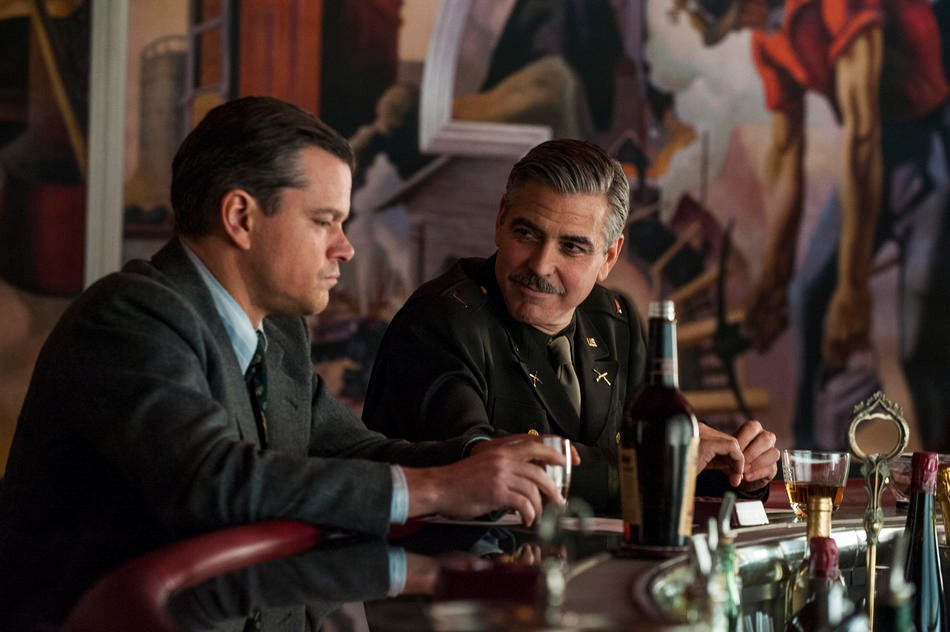A story too little known, the work of a group of some 300 men and women on a most unusual military mission in World War II provides the basis for George Clooney's latest movie, "The Monuments Men." The unit, a decidedly unmilitary bunch of museum curators, artists, art historians, and architects, worked in Europe, landing shortly after the Normandy invasion, seeking to locate and recover hundreds of thousands of works of art that the Germans, under the direction of Hitler and Goering, systematically looted from the countries they conquered and occupied.

- PHOTO COURTESY SONY PICTURES
- Matt Damon and George Clooney in “The Monuments Men.”
The movie reduces the endeavor to the work of seven men from various relevant disciplines, under the command of a scholar, Frank Stokes (George Cooney), the man who persuades President Roosevelt of the necessity of their task. He and his men believe they must rescue Western culture from Hitler, who dreams of stocking his own grand museum with the harvest of centuries of genius. Their difficult and sometimes dangerous task not only demands a hunt for the treasures of the past, but also a desperate race to stop the retreating German army from destroying the works stored in caves and mines. They must also prevent the Soviet army's own unit, the Trophy Brigade, from taking the loot back to Russia.
The picture shows, sometimes comically, Stokes's recruitment of a handful of middle-aged men into his unit, their outfitting and basic training as soldiers of a sort, so they can go to war for the salvation of Western culture. An English and a French officer join the Americans, making their task, like the war itself, a joint effort of the Allies. To locate some of the works, one member of the unit, James Granger (Matt Damon), enlists the help of a brave, clever Frenchwoman, Claire Simone (Cate Blanchett), who worked as a secretary to a German officer and observed Hermann Goering's acquisition of numerous paintings; her ledger of the paintings and their destination allows the Americans to retrieve untold numbers of masterpieces.
The picture's several different stories of the separate Monuments Men sometimes tend to diffuse the picture's narrative focus and weaken its coherence. The great unifying element of the story, however, involves two famous masterpieces, both from Belgian churches, the Ghent Altarpiece and the magnificent Bruges Madonna, the only Michelangelo sculpture to leave Italy. Though probably somewhat fictionalized, the unit's discovery of those two great works generates suspense that turns into real emotion, a genuinely moving moment in the film.
Clooney's direction generously allows all the actors to shine, sometimes humorously, sometimes quite seriously. Playing a character who must be the fattest sergeant in the U. S. Army, John Goodman exemplifies one of his great strengths, mixing somber reactions with a kind of offhand comedy. As the oldest member of the team, Bill Murray displays some of the sadness and loss of all wars when he hears the voices of his daughter and grandchildren on a record, wishing him a Merry Christmas during the Battle of the Bulge.
Unusually, "The Monuments Men" really deserves most of the favorable press that surrounds its release. It tells an important story, it employs a fine cast, and it creates genuine emotion out of so unusual a subject as the search for art. Like a great many of those familiar World War II documentaries, it also provides an astonishing amount of facts about the Nazi theft of a huge, extraordinary artistic treasure hoard, from great paintings and sculptures to rare books and even thousands of church bells.
The picture instructs its audiences in the dedication of a group of men and women who believed in the importance of their mission and in the role of art in creating and sustaining civilization. It may even remind some people of a time when our government actually cared about the work of the Monuments Men, in contrast to the cavalier dismissals of the looting of museums during the Iraq invasion. When the president asks Frank Stokes if the rescue of a great painting or sculpture was worth the life of the person trying to save it, knowing the man and understanding the loss, Stokes defends the sacrifice. After all, as Horace wrote, art is long, life is short.